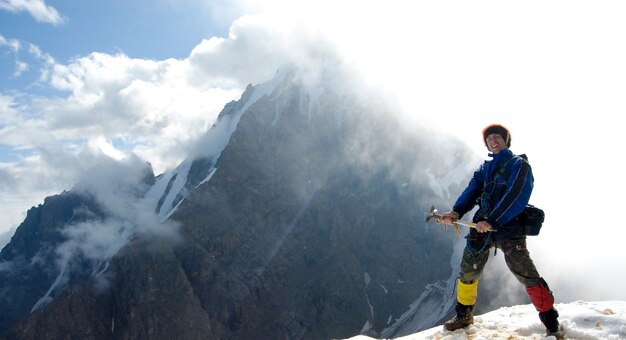The Everest Three Pass Trek is a heart of the Himalayas located with in one of the worlds toughest and remote terrain. We would cross 3 high passes on this trek, Renjo La, Cho La and Kongma La; each of these has its own challenges in the form of steep climbs, rocky trails, glacier crossings amongst other things but most seriously we had to acclimatize ourselves to the thin mountain air. Not only are the picturesque views and sense of accomplishment for completing the trek a big part of the experience, but in reality, success on this journey is largely dependent on a mix between planning, local knowledge, and guidance. And this is why you need a Sherpa guide
Sherpas, the native population of the Khumbu area, have been living in and prospering in the Himalayas for millennia. They are recognized not only for their mountain climbing prowess, but also for their spiritual ties to the mountains. One particularly important advantage to having a Sherpa guide on the Everest Three Passes Trek is their skill and experience. They know the area like the back of their hand; all properties — routes to take, paths to avoid, weather patterns, dangers hazards… everything. Trekking Sherpas are able to adjust the pace of the trek based on what is needed by the group, so you will not only acclimatize properly but also this helps minimize your risk in developing altitude sickness which can be a big issue in such high altitudes.
Sherpa Guide for Everest Three Pass Trek: Introduction
One of the toughest treks on earth, the Everest Three Pass Trek allows trekkers to travel through three high passes — Renjo La, Cho La and Kongma La and an incredible range of visual splendor. But, the extreme challenge level of this trek along with the risk that comes with altitude hiking makes it truly necessary to have a guide who knows what they are doing. Hiring a Sherpa, not only practical for safety reasons but also needed to make the journey more educational and life-enriching. Sherpas are native to the Everest region and have a particular combination of skills, expertise, and regional knowledge that is essential in the often remote and difficult-to-navigate environments of trekking.
Importance of the role of Sherpa guide
So, if we really want to get technical, a Sherpa guide is much more than just a trek leader — and one of the many reasons why hiring one for the Everest Three Passes Trek isn’t even up for debate. Sherpas are experts at trekking, intimately familiar with the terrain and weather and the difficulties that come from high-altitude climbing. They are quite simply guides who will lead trekkers over the arduous trails, including three high altitude passes — Renjo La, Cho La and Kongma La — but they also complete basic training in first aid and emergency procedures which is essential given that at these altitudes altitude sickness, dehydration and fatigue are all frequent. They are aware of the local environment and also adjust the speed to pace so that everyone goes according to his/her acclimatization level so a trekking group climbs slowly in order to lessen the chances of altitude sick.
Difficulty of Everest Three Passes Trek
The Short Everest Three Passes Trek is arguably the most technical, yet high-altitude trek in the world and lumps together some of the toughest trekking conditions going. The journey consists of traversing three high alpine passes—Renjo La, Cho La and Kongma La—all of which are above 5,300 meters (17,400 feet) above sea level — an extraordinary amount of physical burden placed on the body. This high altitude environment depletes localized oxygen and introduces the risk of altitude sickness making acclimatization an essential part of the expedition. In addition, the trail is rough and varied: rocky, glacier-laden landscapes; narrow and steep passages with sections that are ice-slick requiring a unique set of fitness and endurance.
Trekking Through the Terrain & How Sherpas Make Sure They Pass
The Everest Three Passes Trek covers some of the most broken, rugged and changing terrain on Earth so you need to navigate with expert local knowledge and this is where your Sherpa guides come in. Renjo La, Cho La and Kongma La are the three high passes that trekkers will have to traverse through in this trek, passing on steep and rocky trails often times with icy glacial surfaces or very loose slops. Of course, Sherpas have a knack for finding the safest and quickest route through these challenging sections. Due to their experience with the lands, they are aware of what will occur and lead people safely through distractions to ensure trekkers can commence safely without deterrent risks. For instance, the rocky.
The Sherpa and his knowledge of trekking in high altitudes
Sherpas: The Backbone of Everest Region High Altitude Trekking Sherpas are the backbone of high-altitude trekking in the Everest region, and their expertise as high altitude trekking is essential for every success of “Everest Three Passes Trek | 3 Pass 1 Go!” Having lived in, worked in and crawled the high-altitude terrain for centuries, Sherpas are simply second to none when it comes to acclimatizing to their environment. The physiological acclimatization to the high-altitude hypoxic environment allows them to travel rapidly and comfortably, under conditions that would exhaust most trekkers. Sherpas, despite their incredible physical ability, are specially trained in the challenges of climbing at high altitudes such as altitude sickness and how to deal with it and avoid it. They know the subtleties of the weather that impact the trek; they are adept at reacting to rapidly changing circumstances.
AT A HIGHER altitude, a Sherpa knows how to acclimate and stay healthy.
Although acclimatization is not the least important of all on high-altitude trekking, it becomes even more essential on difficult trails like Everest Three Passes Trek which puts trekkers at heights up to 5,300 meters (17,400 feet) above. At those altitudes, the lack of oxygen can lead to altitude sickness that varies from a slight headache and dizziness to life-threatening pulmonary or cerebral edema. And this is where a Sherpa comes in. The sherpas have a better sense of the effects of altitude and how to approach acclimatization in a healthy way.
Mile 50: Cultural Insights — Learning with Sherpas Along Walking Abstand
The Everest Three Passes Trek Map is a physical challenge, but it also offers the chance for real cultural immersion thanks in large part to the number of Sherpas that one will encounter on this trek. The Himalayas: Sherpas are the indigenous people of the Khumbu region, and their Buddhist faith, deep connection to those mountains, and way of life provides a window into the culture of this stunning range. Sherpa guides provide information on culture, history and traditions as trekkers ascend through villages such as Namche Bazaar, Tengboche and Dingboche, with personal stories, spiritual insight and local folklore to add texture to the trek. The deep local knowledge possessed by the Sherpas allows trekkers to learn much more about the cultural significance of places they pass—be it a monastery, stupa or small Sherpa village.
Local Knowledge: Its Pros in Planning and Logistics
One of the most popular routes to participate in is the Everest Trek but because it leads you through such a remote place learning how to get around safely falls more on local experience. And being locals with important knowledge about the logistics of the trek. This knowledge of the trails, seasonal weather patterns and best spots to rest and camp makes all the difference when planning the trip. Sherpas, for example, can guide on when the best time is to cross certain passes in relation to expected weather conditions so that trekkers can avoid being caught out by sudden storms or heavy snowfall. They are also aware of the finest tea houses and lodges to stopover at, allowing trekkers to stay in comfort with adequate food supplies and an opportunity to rest whenever required along the way.
The Simple Things Sherpas Do To Make You Feel Like Home
More than just technical and logistical staff, the Sherpa add an element of experience as they find ways to make you feel welcome, supported and uplifted throughout your trek. Even in difficult situations, trekkers feel comfortable in the presence of their warmth and hospitality. Whether it be with a warm smile, an extra hand to help carry your gear, or a word of reassurance during low points. These personal touches, which are not always visible in a trekking group, are thought to be what allows many trekkers the ability to keep going especially during the more physically punishing parts of a trek. Another quality Sherpas seem to possess incredibly is a deep sense of empathy, allowing them to notice which trekkers may be struggling mentally or physically and provide comfort be it in the form of a word of encouragement.
The Role of Sherpas in Keeping Us Safe, and How to Assess Risks on a Mountain Skills Workshop (AB-W012)
Although the Everest Three Passes Trek Weather is high-risk due to altitude sickness and harsh weather, you should not worry about facing one of the toughest trail terrains on Earth. Sherpas, who have tremendous training and experience, are the main protectors of trekkers’ safety in these harsh environments. They are accustom to spotting the symptoms of altitude sickness, which can become a rapid life-and-death crisis. To reduce the chance of suffering from altitude-related diseases, they will check trekkers’ health and adjust the pace. If symptoms arise, Sherpas can quickly respond by taking trekkers down to lower elevations or seeking medical attention, allowing hikers to get the help they need before their condition deteriorates. Sherpas are also masters of the unforgiving terrain, steering climbers away from danger zones such as loose rock and icy ledges, and anticipating snowstorms.
Trekking with a Sherpa — A Trust and Relationship Built During the Trek
Trekking with a Sherpa on the Everest Three Passes Trek is not just about having an expert guide and supporter but rather an unshakeable bond of trust and mutual respect. From your very first encounter with a Sherpa guide, they not only become an integral part of the journey, but also a powerful source of strength and motivation. The sherpas are use to this terrain, and they know the basics of how a person can trek here. During a psychologically and physically challenging trek, there is solace in knowing that when you are with a Sherpa, you are in safe hands because they have seen it all. As your Sherpa guides you through treacherous passes and shares their wisdom, your trust grows every day. This is a relationship based on common experiences —either overcoming the challenge of a hard pass, braving elements together or pausing to marvel in its immensity.
Sherpas Provide Emotional and Psychological Help
If you are trekking in the Everest region, particularly on a hard route like the Three Passes Trek Itinerary, there will be wear and tear caused not only to your body but also to your mind and spirit. It can sometimes just feel like the altitude, pace, weather and fatigue get to be too much — and on such a difficult day. It is in these moments that having a Sherpa guide to rely on for emotional and psychological support can be crucial. Sherpas are not just guides—they are like outdoor therapists who know how to steer trekkers through the mental side of trekking in the Himalayas. When morale is low, their sunny disposition, a steadfastness under pressure and soft nudging makes all of the difference in the world. Sherpas would share stories of their own, offer up experiences and insight to help keep trekkers focused on the prize.
Sherpas Are Key To Sustainable Tourism And Conservation
Sherpas are vital for sustainable tourism development in Everest area as this helps to keep trekking activities within both ecological and social bounds by ensuring that they bring benefits with minimum costs to local communities. Due to their natives to the land, Sherpas are very intimate with the land, ecology and resources of the regions. They boost the local economy by working as guides, porters, and support staff creating employment opportunities and providing income to families in remote Khumbu. Besides their economic contribution, Sherpas are also important for the conservation of the environment. They are familiar with the fragile ecosystems of the Himalaya and are drive to preserve the natural splendour of this area. Sherpas are engaging in local conservation initiatives related to responsible trekking, waste management and sustainable tourism with minimal environmental impact.
Ethics In Travel: Paying Fairly And Supporting Sherpas
Taking a trek with a Sherpa means being in the presence of great natural beauty and going through an incredible experience, but it also means thinking about treating them well and getting their just compensation. Despite the physical risks of guiding trekkers through the treacherous terrain of the Himalayas, Sherpas have often been undervalued and underpaid in the trekking industry, where they provide vital support to thousands of foreigners visiting Nepal. The workers behind the biggest treks – Sherpas, certainly need support in getting paid fairly for their work. Their work also comprises proper pay for their guiding services, including the expenses done on his/her gear and insurance during their trip along with a secure and ethical surrounding to work throughout the trek. Recent years have also seen more awareness on the need for equitable wages and better working conditions for Sherpas along with efforts to lift their profiles.
How a Sherpa Guide is CRUCIAL to your Everest Three Pass Trek Success – Conclusion
A Sherpa guide is more than a gateway to success on the Everest Three Passes Trek; they are the bedrock. With the trek can be quite a hard work both physically and mentally, Sherpas are invaluable with their expertise, knowledge and support. They are familiar with the terrains, altitudes and weather conditions so trekkers can always placed on the safest path while minimizing risks and making your journey enjoyable. The Sherpas are also a source of vital cultural understanding and emotional support, allowing trekkers to engage with the local customs and remain mentally equipped to handle the struggles that come with trekking. In addition, Sherpas are the ones who promote sustainable tourism and environmental conservation in the Everest area to ensure natural beauty remains preserved in this part of Himalayas forever for generations.










